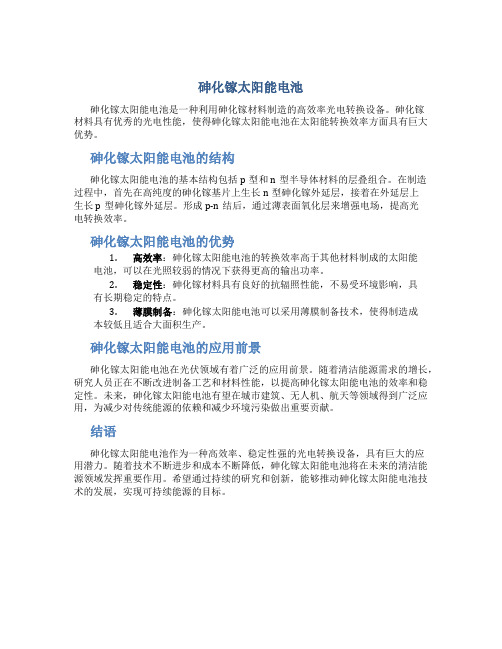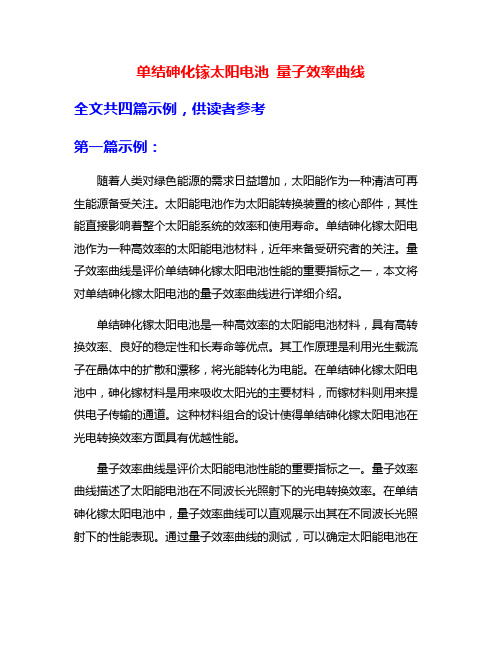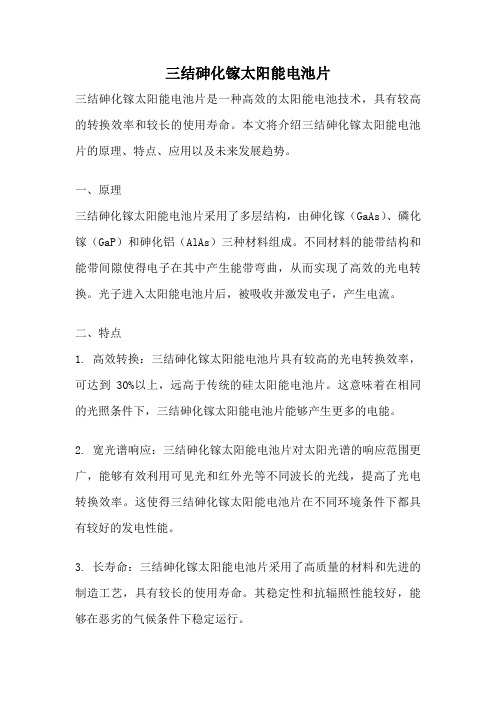砷化镓太阳能电池研究报告
柔性砷化镓太阳电池

l i f t — o f p r o c e s s [ J 】 . E CS J o u r n a l o f S o l i d S t a t e S c i e n c e a n d T e c h n o —
l o g y , 2 0 1 3 , 2 ( 3 ) : 5 8 — 6 5 .
的光 电转换效率 , 另一方面 , 在 比较关键的几道器件工艺上( 比
如键 合 , 剥离 电池衬底 ) 有 很多相 通之处 , 实现起 来更加 的方
便。 2 0 1 4年 , 日本 S H AR P公 司采 用 如 图 2所 示 的 工 艺 , 研 制
D e v i c e L e t t , 2 0 0 9 , 3 0 ( 9 ) : 9 4 0 — 9 4 2 .
C e l l s[ M] . Ga ma n y :S p r i n g e r I n t e na r t i o n a l P u b l i s h i n g , 2 0 1 4 : 6 2 3 —
6 4 3 .
[ 7 ] S C H E R ME R J J , BA UH UI S G J , MUL D E R P , e t a 1 . Hi g h r a t e e p i t a - x i a l l i t f — o f f o f I n G a P i f l ms f r o m Ga As s u b s t r a t e s [ J ] . Ap p l i e d P h y s i c s
[ 6 ] BA U HUI S G J , MUL DE R P , S CH E R ME R J J . Hi g h — E ic f i e n c y S o l r a
砷化镓太阳能电池研究报告 材五第三组

砷化镓太阳能电池研究报告摘要:美国的阿尔塔设备公司使用外延层剥离技术,用砷化镓制造出了最高转化效率达28.4%的薄膜太阳能电池。
这种电池不仅打破了此前的转化效率,其成本也低于其他太阳能电池。
该太阳能电池效率提升的关键并非是让其吸收更多光子而是让其释放出更多光子,未来用砷化镓制造的太阳能电池有望突破能效转化记录的极限。
目前效率最高的商用太阳能电池由单晶硅圆制造,最高转化效率为23%。
砷化镓虽然比硅贵,但其收集光子的效率更高。
就性价比而言,砷化镓是制造太阳能电池的理想材料。
1.砷化镓结构及光电性能砷化镓属于Ⅲ-Ⅴ族化合物,是一种重要的半导体材料,化学式GaAs,分子量144.63,属闪锌矿型晶格结构,晶格常数5.65×10-10m,熔点1237℃。
在300 K 时,砷化镓材料禁带宽度为1.42 eV,如图1。
图1砷化镓能带结构简图砷化镓在自然条件下的结晶态通常具有两种晶体结构:闪锌矿结构或正斜方晶结构。
其中.正斜方晶结构的GaAs只能在高压下获得,闪锌矿结构是室温下GaAs 的最稳定构型。
闪锌矿的晶体构如图2所示。
图2 砷化镓晶体闪锌矿结构闪锌矿的GaAs晶体结构属立方晶系F43m空间群,晶格常数a=O 56535nm.配位数Z=4。
如图2所示的GaAs结构是立方面心格子,Ga2+位于立方面心的结点位置.As交错地分布于立方体内的l/8小立方体的中心,每个Ga2+周围有4个As与之成键.同样,每个As2-。
周围有4个Ga2+,阴阳离子的配位数都是4。
如果将As2-看成是作立方紧密堆积,则Ga2+充填于l/2的四面体空隙。
而正斜方晶结构在高压下才能获得,在温度为300K时,随着压强的增加,GaAs发生从闪锌矿结构GaAs 到正斜方晶GaAs.II的相变。
图3砷化镓能带结构图砷化镓是典型的直接跃迁型能带结构,其能带结构如图3所示。
砷化镓的价带极大值位于布里渊区中心k=O处;导带极小值也位于k=0的逊,等能面为球面。
砷化镓研究报告

砷化镓研究报告砷化镓研究报告砷化镓简介•砷化镓是一种半导体材料,具有广泛应用前景。
•砷化镓具有优异的电子特性和光电特性,适用于多种应用领域。
砷化镓的制备方法•气相外延法•分子束外延法•金属有机化学气相沉积法砷化镓的性质和特点•高电子迁移率•高饱和漂移速度•强耐辐照性•宽的能带隙•优异的导电性和光电特性砷化镓的应用领域1.电子器件•高频功率放大器•混频器•高速开关2.光电子器件•光电探测器•激光器•光电发射器3.太阳能电池4.无线通信领域•5G通信•卫星通信砷化镓研究的进展和挑战•砷化镓在电子器件领域具有广泛应用,但仍面临一些挑战和问题。
•应继续研究砷化镓材料的改性和优化方法,以提高其性能和稳定性。
结论•砷化镓作为一种重要的半导体材料,在电子器件和光电子器件领域有着广泛的应用前景。
•砷化镓的研究将会继续推动半导体技术的发展,为现代科技的进步做出贡献。
以上是关于砷化镓研究报告的相关内容,希望对读者了解砷化镓及其应用领域有所帮助。
砷化镓研究报告砷化镓简介•砷化镓是一种半导体材料,具有广泛应用前景。
•砷化镓具有优异的电子特性和光电特性,适用于多种应用领域。
砷化镓的制备方法•气相外延法•分子束外延法•金属有机化学气相沉积法砷化镓的性质和特点•高电子迁移率•高饱和漂移速度•强耐辐照性•宽的能带隙•优异的导电性和光电特性砷化镓的应用领域1. 电子器件•高频功率放大器•混频器•高速开关2. 光电子器件•光电探测器•激光器•光电发射器3. 太阳能电池4. 无线通信领域•5G通信•卫星通信砷化镓研究的进展和挑战•砷化镓在电子器件领域具有广泛应用,但仍面临一些挑战和问题。
•目前的研究重点是改进砷化镓的制备方法,提高其晶体质量和成膜速度。
•同时还需要研究砷化镓材料的稳定性和可靠性,以确保其长期稳定工作。
结论•砷化镓作为一种重要的半导体材料,在电子器件和光电子器件领域有着广泛的应用前景。
•砷化镓的研究将会继续推动半导体技术的发展,为现代科技的进步做出贡献。
单结砷化镓太阳电池 量子效率曲线-概述说明以及解释

单结砷化镓太阳电池量子效率曲线-概述说明以及解释1.引言1.1 概述概述单结砷化镓太阳电池是一种高效、稳定且环保的光伏材料,具有较高的光电转换效率和长期稳定性,逐渐成为太阳能领域的研究热点。
量子效率曲线则是评估太阳电池性能的重要指标,能够准确反映材料在不同波长光照下的光电转换效率。
本文将对单结砷化镓太阳电池以及其量子效率曲线进行深入探讨,以期为太阳能电池的研究提供参考和启示。
文章结构部分的内容应该包括对整篇文章内容的简要介绍,以引导读者更好地理解文章的主题和内容安排。
下面是对文章结构部分的内容的一个建议编写:1.2 文章结构:这篇文章主要围绕着单结砷化镓太阳电池以及其量子效率曲线展开讨论。
首先,我们将介绍单结砷化镓太阳电池的基本原理和特点,包括其材料、结构和工作原理。
接着,我们将深入探讨量子效率曲线在太阳能电池性能评估中的重要性与应用。
通过对这两个主题的分析,我们希望能够深入了解单结砷化镓太阳电池的性能,并探讨如何通过量子效率曲线来评价和优化其性能。
最后,我们将总结本文的重点,展望未来单结砷化镓太阳电池领域的发展方向。
通过本文的阐述,读者将能够更好地理解和应用单结砷化镓太阳电池及其量子效率曲线在太阳能领域的研究和实践中的意义。
1.3 目的目的部分的内容如下:目的:本文旨在探讨单结砷化镓太阳电池的量子效率曲线特性及其影响因素,通过研究量子效率曲线,深入分析砷化镓太阳电池的光电转换效率,为进一步提高太阳能电池的性能和应用提供理论基础和指导意义。
同时,通过对量子效率曲线的研究,可以为砷化镓太阳电池的工程应用和优化设计提供重要参考。
2.正文2.1 单结砷化镓太阳电池单结砷化镓太阳电池是一种高效率的太阳能电池,利用砷化镓作为光电转换材料,能够将太阳光转化为电能。
砷化镓具有优秀的光电性能,其带隙较大,适合吸收可见光和红外光线,具有高光电转换效率。
单结砷化镓太阳电池的工作原理是,当光线照射在砷化镓材料上时,光子能量被吸收,激发电子从价带跃迁至导带,形成电子空穴对。
砷化镓研究报告(一)

砷化镓研究报告(一)砷化镓研究报告1. 简介在本篇研究报告中,我们将重点关注砷化镓的相关研究,探讨其特性、应用以及未来的发展方向。
2. 特性•高电子迁移率:砷化镓是一种具有高电子迁移率的半导体材料,具备优异的导电性能。
•宽带隙:砷化镓具有较大的能隙,使其在高频器件和光电子器件中具有独特的优势。
•高效率:利用砷化镓制造的器件,如太阳能电池和激光器,能够实现高效能的能量转换。
•热稳定性:相比其他材料,砷化镓在高温环境下表现出更好的稳定性和可靠性。
3. 应用领域砷化镓材料在许多领域都有广泛的应用,包括但不限于以下几个方面:3.1 光电子器件•高性能激光器•高亮度LED•高速光通信器件3.2 太阳能电池•高效率多接触太阳能电池•高效率多结太阳能电池3.3 射频器件•高频功率放大器•高速开关4. 未来发展方向砷化镓作为一种重要的半导体材料,在未来的发展中有着巨大的潜力。
以下是我们对砷化镓发展方向的一些建议:4.1 器件性能提升不断提高砷化镓器件的性能,如电子迁移率、发光效率等,以满足不断变化的市场需求。
4.2 新应用的探索探索砷化镓在新兴领域的应用潜力,如量子计算、人工智能等,以拓展砷化镓的市场份额。
4.3 减少成本通过技术创新和工艺改进,降低砷化镓材料的生产成本,以提高其市场竞争力。
结论砷化镓作为一种具有优异特性的半导体材料,在光电子器件、太阳能电池、射频器件等领域都有广泛的应用。
未来,我们应不断提高砷化镓器件的性能、探索新应用,并减少其生产成本,以进一步促进其发展。
5. 参考文献•Smith, J., & Johnson, R. (2010). Advances in Gallium Arsenide Research. Journal of Advanced Materials,22(4), .•Brown, A., & Lee, C. (2015). Gallium Arsenide in Optoelectronics: Overview and Recent Advances. OpticsExpress, 23(11), .•Zhang, Y., & Xu, B. (2018). GaAs-Based Solar Cells: Characteristics, Performance, and Prospects. Renewable Energy, 127, .•Di Carlo, A., & Forni, G. (2019). Gallium Arsenide Devices for High-Frequency Applications: Challenges and Opportunities. IEEE Journal of Solid-State Circuits,54(3), .以上是一些关于砷化镓研究的主要参考文献,供读者深入了解该材料的特性、应用和未来发展方向。
砷化镓太阳能电池

砷化镓太阳能电池
砷化镓太阳能电池是一种利用砷化镓材料制造的高效率光电转换设备。
砷化镓
材料具有优秀的光电性能,使得砷化镓太阳能电池在太阳能转换效率方面具有巨大优势。
砷化镓太阳能电池的结构
砷化镓太阳能电池的基本结构包括p型和n型半导体材料的层叠组合。
在制造过程中,首先在高纯度的砷化镓基片上生长n型砷化镓外延层,接着在外延层上
生长p型砷化镓外延层。
形成p-n结后,通过薄表面氧化层来增强电场,提高光
电转换效率。
砷化镓太阳能电池的优势
1.高效率:砷化镓太阳能电池的转换效率高于其他材料制成的太阳能
电池,可以在光照较弱的情况下获得更高的输出功率。
2.稳定性:砷化镓材料具有良好的抗辐照性能,不易受环境影响,具
有长期稳定的特点。
3.薄膜制备:砷化镓太阳能电池可以采用薄膜制备技术,使得制造成
本较低且适合大面积生产。
砷化镓太阳能电池的应用前景
砷化镓太阳能电池在光伏领域有着广泛的应用前景。
随着清洁能源需求的增长,研究人员正在不断改进制备工艺和材料性能,以提高砷化镓太阳能电池的效率和稳定性。
未来,砷化镓太阳能电池有望在城市建筑、无人机、航天等领域得到广泛应用,为减少对传统能源的依赖和减少环境污染做出重要贡献。
结语
砷化镓太阳能电池作为一种高效率、稳定性强的光电转换设备,具有巨大的应
用潜力。
随着技术不断进步和成本不断降低,砷化镓太阳能电池将在未来的清洁能源领域发挥重要作用。
希望通过持续的研究和创新,能够推动砷化镓太阳能电池技术的发展,实现可持续能源的目标。
砷化镓太阳能电池发展趋势

转化效率
砷化镓(GaAs)III-V化合物电池的转换效率可达28%,GaAs化合物材料具有十分理想 的光学带隙以及较高的吸收效率,抗辐照能力强,对热不敏感,适合于制造高效 单结电池。
砷化镓太阳能电池的发展趋势
目前的发展情况
在2008年,全球的砷化镓电池的生产取得突破性的发展,4 月,作为砷化镓生产的全球主要厂家之一SpectroLab,获 得350兆瓦,9300万美元(1000倍聚光)的电站订单。
制备方法
砷化镓需要采用磊晶技术制造,这种磊晶圆的直径通常为4—6英寸,比硅晶圆的 12英寸要小得多。磊晶圆需要特殊的机台,同时砷化镓原材料成本高出硅很多, 最终导致砷化镓成品IC成本比较高。磊晶目前有两种,一种是化学的MOCVD,一 种是物理的MBE。GaAs等III-V化合物薄膜电池的制备主要采用MOVPE和LPE技术, 其中MOVPE方法制备GaAs薄膜电池受衬底位错,反应压力,III-V比率,总流量等 诸多参数的影响。 GaAs(砷化镓)光电池大多采用液相外延法或MOCVD技术制备。 用GaAs作衬底的光电池效率高达29.5%(一般在19.5%左右) ,产品耐高温和辐射, 但生产成本高,产量受限,目前主要作空间电源用。
2007年8月开始,由于聚光技术的采用,砷化镓电池从卫星 上的使用转变为聚光的太阳能发电站的规模应用。为此, Emcore公司花了1000万美元,将产能增加到目前的每年 150兆瓦。 在东亚地区,也有初步的生产推广,2008年5月,韩国电站 就接到70兆瓦,2800万美元(500倍聚光)的订单。
目前应用
砷化镓太阳能电池发展趋势
目录
一、砷化镓太阳能电池简介 定义及制造方法 制备方法 转化效率 二、砷化镓太阳能电池的发展趋势 目前发展情况 目前应用 发展趋势和壁垒
2024年砷化镓市场分析现状

砷化镓市场分析现状引言砷化镓是一种重要的半导体材料,具有优异的电学性能和光电性能,广泛应用于光电子、半导体器件、光纤通信等领域。
本文将对砷化镓市场的现状进行分析,并展望未来的发展趋势。
砷化镓市场规模及发展动态根据市场调研公司的数据显示,全球砷化镓市场规模在过去几年保持了稳健增长的态势。
砷化镓市场的发展主要受到电子产品需求、通信市场扩张、新能源汽车等多个因素的影响。
电子产品需求推动砷化镓市场增长随着移动互联网的快速发展,智能手机、平板电脑等电子产品的需求不断增加,这直接推动了砷化镓市场的增长。
砷化镓材料被广泛用于高频和高功率器件的制造,如射频功率放大器和高速开关等。
其中,射频功率放大器在手机基带解调器和射频前端模块中扮演着重要的角色,对砷化镓的需求量大。
通信市场扩张带动砷化镓市场需求增加5G通信的快速发展也是砷化镓市场增长的重要推动因素。
砷化镓材料在5G射频前端模块中具有重要作用,其高频性能和能耗特性优于其他材料。
随着5G通信网络的建设和规模化商用,砷化镓市场将迎来更广阔的发展空间。
新能源汽车市场增长催化砷化镓需求随着全球对节能环保的需求不断提高,新能源汽车市场逐渐崛起。
砷化镓在新能源汽车电动驱动系统、高效充电器等方面具有广泛应用。
预计随着新能源汽车市场的不断扩大,对砷化镓的需求也将持续增长。
砷化镓市场供应链及竞争格局砷化镓市场的供应链主要包括砷化镓原材料供应商、芯片制造商和终端产品制造商。
目前,全球砷化镓市场竞争激烈,主要的制造商集中在亚洲地区。
砷化镓原材料供应商砷化镓原材料供应商主要集中在美国、中国和日本等地。
其中,美国是全球砷化镓原料的主要产地,拥有丰富的砷资源。
中国和日本等地也有一些知名的砷化镓原料供应商,为市场的稳定供应提供了保障。
芯片制造商砷化镓市场的芯片制造商主要集中在亚洲地区,特别是台湾、韩国和中国。
这些地区拥有成熟的半导体制造技术和产业链,为砷化镓芯片的生产提供了良好的基础。
同时,这些地区的企业还积极推动技术创新和产品升级,提高了产品的竞争力。
单结砷化镓太阳电池 量子效率曲线

单结砷化镓太阳电池量子效率曲线全文共四篇示例,供读者参考第一篇示例:随着人类对绿色能源的需求日益增加,太阳能作为一种清洁可再生能源备受关注。
太阳能电池作为太阳能转换装置的核心部件,其性能直接影响着整个太阳能系统的效率和使用寿命。
单结砷化镓太阳电池作为一种高效率的太阳能电池材料,近年来备受研究者的关注。
量子效率曲线是评价单结砷化镓太阳电池性能的重要指标之一,本文将对单结砷化镓太阳电池的量子效率曲线进行详细介绍。
单结砷化镓太阳电池是一种高效率的太阳能电池材料,具有高转换效率、良好的稳定性和长寿命等优点。
其工作原理是利用光生载流子在晶体中的扩散和漂移,将光能转化为电能。
在单结砷化镓太阳电池中,砷化镓材料是用来吸收太阳光的主要材料,而镓材料则用来提供电子传输的通道。
这种材料组合的设计使得单结砷化镓太阳电池在光电转换效率方面具有优越性能。
量子效率曲线是评价太阳能电池性能的重要指标之一。
量子效率曲线描述了太阳能电池在不同波长光照射下的光电转换效率。
在单结砷化镓太阳电池中,量子效率曲线可以直观展示出其在不同波长光照射下的性能表现。
通过量子效率曲线的测试,可以确定太阳能电池在不同波长光照射下的光电转换效率,帮助研究者深入了解单结砷化镓太阳电池的工作机制和性能特点。
在实际测试中,要获得单结砷化镓太阳电池的量子效率曲线,首先需要将电池置于暗室中进行预处理,确保电池的状态达到稳定。
然后,使用光源照射电池,并测量电池在不同波长光照射下的输出电流和输出功率。
根据测量数据,可以计算出太阳能电池在不同波长光照射下的量子效率,进而绘制出量子效率曲线。
通过对单结砷化镓太阳电池的量子效率曲线进行分析,可以得到电池在不同波长光照射下的性能特点。
根据量子效率曲线,研究者可以确定电池的光吸收范围、光电转换效率、光电导率等关键性能参数。
同时,量子效率曲线也可以揭示出电池在不同波长光照射下的光电转换机制,为进一步优化太阳能电池的性能提供重要参考。
砷化镓太阳能电池的产业背景分析

4
砷化镓电池与硅光电池比较
性能
砷化镓电池 硅光电池
光电 转化率
单结:27% 多结:50%
以上
23%
耐高温性
250℃
低于 200℃
抗辐射性
高2倍
低
3
砷化镓电池的两种技术
1. LPE技术:液相外延技术LiquidPhaseEpitaxy;简称LPE1963年由Nelson等人提出 的;在GaAs的生产中;其以低熔点的Ga镓为溶剂;以待生长材料Ga、As砷和掺杂剂Zn 锌、Te碲、Sn锡等为溶质;使溶质在溶剂中呈饱和或过饱和状态&通过降冷却使石墨 舟中的溶质从溶剂中析出;在单晶衬底上定向生长一层晶体结构和晶格常数与单晶衬 底常为Ga足够相似的GaAs晶体材料;使晶体结构得以延续;实现晶体的外延生长
14
7
砷化镓太阳能电池未来发 展趋势
空间用砷化镓太阳能电池技术发展趋势 : 未来空间用砷化镓太阳能电池的技术发展; 将以提高电池产品光电转换效率和提高 抗辐射能力为主要方向& 地面聚光砷化镓太阳能电池技术发展趋势 : 未来地面聚光砷化镓太阳能电池的技术发展; 主要以提高电池芯片光电转换效率、 更 高聚光倍数电池的研制、提高聚光组件聚光效率和研发更高效的追踪技术为主要方向 &
业发展;在成本竞争不具备优势的情况下;策支持的不力使砷化镓产业化推进缓慢&以上这些原因 的综合出现;对砷化镓电池产业的发展造成了障碍&
砷化镓太阳能电池

砷化镓太阳能电池砷化镓简介一种重要的半导体材料。
由于其电子迁移率比硅大5~6倍,故在制作微波器件和高速数字电路方面得到重要应用。
用砷化镓制成的半导体器件具有高频、高温、低温性能好、噪声小、抗辐射能力强等优点。
砷化镓是半导体材料中,兼具多方面优点的材料,但用它制作的晶体三极管的放大倍数小,导热性差,不适宜制作大功率器件。
虽然砷化镓具有优越的性能,但由于它在高温下分解,故要生长理想化学配比的高纯的单晶材料,技术上要求比较高。
据专家介绍,砷化镓可在一块芯片上同时处理光电数据,因而被广泛应用于遥控、手机、DVD计算机外设、照明等诸多光电子领域。
另外,因其电子迁移率比硅高6倍,砷化镓成为超高速、超高频器件和集成电路的必需品。
砷化镓单晶片的价格大约相当于同尺寸硅单晶片的20至30倍。
尽管价格不菲,目前国际上砷化镓半导体的年销售额仍在10亿美元以上。
20世纪80年代初,技术专家认为砷化镓将在制造半导体中最终取代硅。
这是因为电子在砷化镓中运动的速度比在硅中运动的速度快5至10倍。
但砷化镓比较难于制造和加工,在它上面组装晶体管不能像在硅片上那样密集,价格也高。
以上来自百度百科GaAs属于III-V族化合物半导体材料,其能隙与太阳光谱的匹配较适合,且能耐高。
与硅太阳电池相比,GaAs太阳电池具有较好的性能光电转化率砷化镓的禁带较硅为宽,使得它的光谱响应性和空间太阳光谱匹配能力较硅好。
目前,硅电池的理论效率大概为23%,而单结的砷化镓电池理论效率达到27%,而多结的砷化镓电池理论效率更超过50%。
目前全世界专业制作砷化镓聚光电池的工厂有美国的Emc ore,Spectr oLab(波音的子公司)和德国的Az urSpa ce等,中国的产业化推广还未成形。
太阳能电池砷化镓供电时发生的变化

太阳能电池砷化镓供电时发生的变化
当太阳能电池以砷化镓作为材料进行供电时,会发生一系列变化。
首先,砷化镓太阳能电池能够将太阳光转换为电能的效率相对较高,因为砷化镓具有较高的吸收系数和较短的电子扩散长度,这意味着它能更有效地吸收太阳光并将其转化为电能。
其次,砷化镓太阳能电池具有较高的工作温度范围,这意味着在高温环境下仍能保持较高的效率,这对于热带地区或者需要长时间曝晒在太阳下的场合非常有利。
另外,砷化镓太阳能电池还具有较高的抗辐照性能,即在高辐射环境下仍能保持较高的性能,这使得它在太空或者高海拔等环境中具有独特的优势。
此外,砷化镓太阳能电池的制造成本相对较高,但随着技术的进步和规模化生产,成本有望逐渐降低。
总的来说,砷化镓太阳能电池在供电时能够提供高效率、高温工作能力和抗辐照性能,这使得它在特定环境下具有重要的应用前景。
希望这些信息能够对你有所帮助。
砷化镓太阳能电池

分 子“ 电动 车"
据英 国广播公司 ( B ) B C 报道 , 兰科 荷 学家展示 了全球 最小的、 由单个分子制成 的分子 “ 电动 车” 该 “ , 电动车 ” 也有 4个 “ 轮子” 当施加微 弱电流时 , 向前行驶。 , 会 科学家们表示 , 这种分子“ 电动车” 有望应 用 于许 多微 观 领 域 , 比如 把 微 量 药 物 送 到 人体特 定位 置等 。相 关研 究 发表 在 最 新一 期《 自然》 杂志上。 未来任何在纳米尺度工作 的人工运输 装 置和机 器 人 , 可 能 需 要 能 在 一 个 表 面 都 上定 向平移 的分 子。然而, 在设计这种分 子时, 科学家们通常利用光能、 化学能或 电 能来调控该分子 与表 面的互 动 , 研究工作 面 临很 大 障碍 。 荷兰屯特大学的化学家蒂博尔 ・ 贝 库 纳奇领 导 的科研 小 组 通过 将 4个 旋 转 的运 动单元 ( 相当于汽车的4个轮子 ) 附着到一 个 中心 轴 上 , 造 出一 个 可 定 向移 动 的 分 制 子。如果用特别细小 的探针触碰一下该分 子, 为之提供微弱电流, 4个“ 轮子” 就会开 始旋转 , 驱动 整个分子前行。他们 在铜板 表面对分子 “ 电动 车” 进行 了测试 , 结果 显 示, 施加 1 O次电流 , 该分子 “ 电动车” 就可 以行进 6纳米 。 库贝纳奇解释说 , 这辆 “ 电动车” 的工 作原理与很多生物体组织 中天然存在的现 象 类似 。在 机 体 组织 中 , 些 蛋 白质 受 电 有 流刺激后 会变 形 , 而 产 生运 动 , 肉收 缩 从 肌 就 是基 于该 原 理 。在 该 研 究 中 , 加 电 流 施 后, 转子吸收电子 , 会诱导转子 的结构发生 变 化 , 动 该 分 子 在 铜 表 面 移 动 。通 过 改 推 变各运动单元 的旋转运动方 向, 这个 自我 推进 的分子“ 四轮” 结构便能沿随机 的轨迹 运动或优先沿线性轨迹运动。库贝纳奇指 出, 这种设计 为探索更复杂 的分子机 械系 统提供了起点 , 未来科 学家们或许 能对 它 们的运动方向完全进行控制。 不过 , 因为最 新研 究 是 在 一26 的低 2℃ 温和高度真空环境 中完成 的, 这样 的分子 “ 电动 车 ” 用 于 实 际还 很 遥 远 , 务 之 急 应 当 是让其能在正常环境下工作。
砷化镓太阳电池

1、GaAs太阳电池的发展历程
2、GaAs太阳电池的材料性质
Ga As原子序数及电子排布
3、Ⅲ-V族化合物太阳电池与硅比较具有的特性有哪些?
1、GaAs的发展历程
1954
世界上首次发现GaAs材料具有光伏效应
1956
理论上估算,GaAs单结太阳电池的效率可达27%
Gobat等研制了第1个掺锌GaAs太阳电池 采用LPE(液相外延)技术引入GaAlAs异质窗口层,降低了 GaAs表面的复合速率,使GaAs太阳电池的效率达16% 实验室最高效率已达到50%(来自IBM公司数据) 产业生产转化率可达30%以上
机械强度较弱,易碎; 怎么办?思考题
制备困难,砷化镓在一定条件下容易分解,而且砷材料 是一种易挥发性物质,在其制备过程中,要保证严格的 化学计量比是一件困难的事。 材料密度大,GaAs材料密度为5.32g/cm3,是Si材料密 度的2倍多
课外任务
任务二、 GaAs太阳电池的结构及制备工艺
作业
作业、 简述GaAs太阳电池的特点
20世纪60年代
20世纪70年代
世纪80年代后
1、GaAs的发展历程——曲折
砷化镓单晶在应用上曾遭受到不少挫折。
首先用它来作晶体管和二极管,结果其性能还赶不上硅和锗。到了60年代 初,出现了耿氏微波二极管,人们曾寄希望于将此器件取代真空速调管,使雷 达实现固体化。后终因输出功率太小而未能实现。 在改善计算机性能中,用砷化镓制成了超高速电路,可以提高计算机的计 算速度,这个应用十分诱人,但是后来开发出计算机平行计算技术,又给砷化 镓的应用浇了一飘冷水。
2、GaAs材料的性质
晶体结构:GaAs材料的晶体结构属于闪锌矿型晶格 结构。
化学键:四面体键,键角为109’28’,主要为共价成分。由于镓、砷原子 不同,吸引电子的能力不同,共价键倾向砷原子,具有负电性,导致GaAs键具有一定的离子特性,使得砷化镓材料具有独特的性质。
三结砷化镓太阳能电池片

三结砷化镓太阳能电池片三结砷化镓太阳能电池片是一种高效的太阳能电池技术,具有较高的转换效率和较长的使用寿命。
本文将介绍三结砷化镓太阳能电池片的原理、特点、应用以及未来发展趋势。
一、原理三结砷化镓太阳能电池片采用了多层结构,由砷化镓(GaAs)、磷化镓(GaP)和砷化铝(AlAs)三种材料组成。
不同材料的能带结构和能带间隙使得电子在其中产生能带弯曲,从而实现了高效的光电转换。
光子进入太阳能电池片后,被吸收并激发电子,产生电流。
二、特点1. 高效转换:三结砷化镓太阳能电池片具有较高的光电转换效率,可达到30%以上,远高于传统的硅太阳能电池片。
这意味着在相同的光照条件下,三结砷化镓太阳能电池片能够产生更多的电能。
2. 宽光谱响应:三结砷化镓太阳能电池片对太阳光谱的响应范围更广,能够有效利用可见光和红外光等不同波长的光线,提高了光电转换效率。
这使得三结砷化镓太阳能电池片在不同环境条件下都具有较好的发电性能。
3. 长寿命:三结砷化镓太阳能电池片采用了高质量的材料和先进的制造工艺,具有较长的使用寿命。
其稳定性和抗辐照性能较好,能够在恶劣的气候条件下稳定运行。
三、应用1. 太空航天:由于三结砷化镓太阳能电池片具有高效转换和宽光谱响应的特点,因此在太空航天领域得到广泛应用。
太空航天器需要在极端的温度和辐射条件下工作,而三结砷化镓太阳能电池片能够稳定地提供电能,保证太空任务的顺利进行。
2. 军事领域:三结砷化镓太阳能电池片的高效转换和稳定性使其在军事领域有广泛的应用。
无人机、侦察设备等军事装备需要长时间的独立供电,而三结砷化镓太阳能电池片能够满足其高能耗的需求。
3. 移动通信:随着移动通信技术的发展,对电池供电的需求也越来越大。
三结砷化镓太阳能电池片具有高效转换和较长的使用寿命,能够为移动通信设备提供可靠的电能供应。
四、未来发展趋势随着能源需求的增加和环境问题的日益突出,太阳能作为一种清洁、可再生的能源形式受到越来越多的关注。
砷化镓太阳电池(终稿)

砷化镓太阳能电池摘要本文主要对砷化镓太阳电池的结构、性能、研制及生产情况作了简单介绍,分析了GaAs太阳电池的发展方向,最后根据GaAs太阳电池的研制进展和空间试用情况,提出了发展GaAs太阳电池的设想。
关键词:砷化镓太阳能电池; 技术; 进展引言:近年来,太阳能光伏发电在全球取得长足发展。
常用光伏电池一般为多晶硅和单晶硅电池,然而由于原材料多晶硅的供应能力有限,加上国际炒家的炒作,导致国际市场上多晶硅价格一路攀升,最近一年来,由于受经济危机影响,价格有所下跌,但这种震荡的现状给光伏产业的健康发展带来困难。
目前,技术上解决这一困难的途径有两条:一是采用薄膜太阳电池,二是采用聚光太阳电池,减小对原料在量上的依赖程度。
常用薄膜电池转化率较低,因此新型的高倍聚光电池系统受到研究者的重视。
聚光太阳电池是用凸透镜或抛物面镜把太阳光聚焦到几倍、几十倍,或几百倍甚至上千倍,然后投射到太阳电池上。
这时太阳电池可能产生出相应倍数的电功率。
它们具有转化率高,电池占地面积小和耗材少的优点。
高倍聚光电池具有代表性的是砷化镓(GaAs)太阳电池。
1.砷化镓简介砷化镓是一种重要的半导体材料,属Ⅲ-Ⅴ族化合物半导体,化学式GaAs,分子量144.63,属闪锌矿型晶格结构,晶格常数5.65×10-10m,熔点1237℃,禁带宽度1.4电子伏。
砷化镓于1964年进入实用阶段,砷化镓可以制成电阻率比硅、锗高3个数量级以上的半绝缘高阻材料,用来制作集成电路衬底、红外探测器、γ光子探测器等。
由于其电子迁移率比硅大5~6倍,故在制作微波器件和高速数字电路方面得到重要应用。
用砷化镓制成的半导体器件具有高频、高温、低温性能好、噪声小、抗辐射能力强等优点。
此外,还可以用于制作转移器件──体效应器件。
砷化镓是半导体材料中,兼具多方面优点的材料,但用它制作的晶体三极管的放大倍数小,导热性差,不适宜制作大功率器件。
虽然砷化镓具有优越的性能,但由于它在高温下分解,故要生长理想化学配比的高纯的单晶材料,技术上要求比较高.2.发展历程GaAs太阳电池的发展是从上世纪50年代开始的,至今已有已有50多年的历史。
- 1、下载文档前请自行甄别文档内容的完整性,平台不提供额外的编辑、内容补充、找答案等附加服务。
- 2、"仅部分预览"的文档,不可在线预览部分如存在完整性等问题,可反馈申请退款(可完整预览的文档不适用该条件!)。
- 3、如文档侵犯您的权益,请联系客服反馈,我们会尽快为您处理(人工客服工作时间:9:00-18:30)。
砷化镓太阳能电池研究报告
英文回答:
Research Report on Gallium Arsenide Solar Cells.
Introduction:
Gallium arsenide (GaAs) solar cells have gained significant attention in recent years due to their high efficiency and potential for use in various applications. In this research report, I will discuss the advantages, challenges, and future prospects of GaAs solar cells.
Advantages of GaAs Solar Cells:
1. High Efficiency: GaAs solar cells have a higher conversion efficiency compared to traditional silicon-based solar cells. This is due to the direct bandgap of GaAs, which allows for efficient absorption of sunlight and higher energy conversion.
2. Wide Spectral Range: GaAs solar cells can convert a broader range of the solar spectrum into electricity, including both visible and infrared light. This makes them suitable for use in space applications where sunlight is limited.
3. Temperature Stability: GaAs solar cells exhibit better temperature stability compared to silicon-based solar cells. They can maintain their efficiency even at high temperatures, making them suitable for use in hot climates.
4. Flexibility: GaAs solar cells can be fabricated on flexible substrates, allowing for the production of lightweight and flexible solar panels. This makes them
ideal for applications where weight and portability are important, such as portable chargers and wearable devices.
Challenges of GaAs Solar Cells:
1. Cost: GaAs solar cells are more expensive to produce
compared to silicon-based solar cells. The high cost is mainly attributed to the complex manufacturing process and the use of expensive materials like gallium and arsenic.
2. Limited Availability: Gallium and arsenic, the key materials used in GaAs solar cells, are relatively rare and expensive. This limits the availability and scalability of GaAs solar cell production.
3. Toxicity: Arsenic, a component of GaAs solar cells, is highly toxic and poses environmental risks during the manufacturing and disposal processes. Proper handling and disposal measures are necessary to mitigate these risks.
Future Prospects:
Despite the challenges, GaAs solar cells hold great promise for the future of solar energy. Ongoing research and development efforts are focused on addressing the cost and availability issues associated with GaAs solar cells. For example, researchers are exploring alternative materials and manufacturing techniques to reduce production
costs. Additionally, advancements in nanotechnology may enable the development of more efficient and cost-effective GaAs solar cells.
In conclusion, GaAs solar cells offer several advantages over traditional silicon-based solar cells, including higher efficiency, wider spectral range, temperature stability, and flexibility. However, they also face challenges such as high production costs, limited availability of materials, and toxicity concerns. With continued research and technological advancements, GaAs
solar cells have the potential to revolutionize the solar energy industry and contribute to a more sustainable future.
中文回答:
砷化镓太阳能电池研究报告。
引言:
砷化镓(GaAs)太阳能电池近年来备受关注,因其高效率和在
各种应用中的潜力而备受关注。
在这份研究报告中,我将讨论砷化
镓太阳能电池的优势、挑战和未来前景。
砷化镓太阳能电池的优势:
1. 高效率,与传统的硅基太阳能电池相比,砷化镓太阳能电池
具有更高的转换效率。
这是由于砷化镓的直接带隙,使其能够高效
吸收阳光并实现更高的能量转换。
2. 宽光谱范围,砷化镓太阳能电池可以将更广泛的太阳光谱转
换为电能,包括可见光和红外线。
这使其适用于太阳光有限的空间
应用。
3. 温度稳定性,砷化镓太阳能电池具有比硅基太阳能电池更好
的温度稳定性。
它们可以在高温下保持其效率,适用于炎热气候中
的使用。
4. 灵活性,砷化镓太阳能电池可以在柔性基板上制造,生产轻
便灵活的太阳能电池板。
这使其非常适合重量和便携性重要的应用,如便携式充电器和可穿戴设备。
砷化镓太阳能电池的挑战:
1. 成本,与硅基太阳能电池相比,砷化镓太阳能电池的生产成
本更高。
高成本主要归因于复杂的制造工艺和使用昂贵的镓和砷等
材料。
2. 有限供应,砷化镓太阳能电池的关键材料镓和砷相对稀缺且
昂贵。
这限制了砷化镓太阳能电池的可用性和可扩展性。
3. 毒性,砷是砷化镓太阳能电池的组成部分,具有高毒性,在
制造和处理过程中存在环境风险。
需要采取适当的处理和处置措施
以减轻这些风险。
未来前景:
尽管存在挑战,砷化镓太阳能电池在太阳能领域有着巨大的前景。
持续的研究和开发工作致力于解决砷化镓太阳能电池的成本和
供应问题。
例如,研究人员正在探索替代材料和制造技术,以降低
生产成本。
此外,纳米技术的进展可能实现更高效和经济实惠的砷
化镓太阳能电池的开发。
总之,砷化镓太阳能电池相对于传统的硅基太阳能电池具有多
个优势,包括更高的效率、更宽的光谱范围、温度稳定性和灵活性。
然而,它们也面临成本高、材料供应有限和毒性问题的挑战。
通过
持续的研究和技术进步,砷化镓太阳能电池有望改变太阳能行业,并为更可持续的未来做出贡献。
